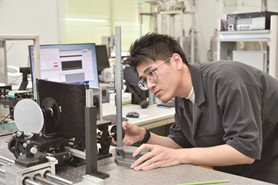◆Key points
- To observe the state of the universe before the hot Big Bang, it is necessary to observe the polarization of the afterglow of the Big Bang across the entire sky with an accuracy that is an order of magnitude higher than the past experiments.
- In this study, we developed a high-speed simulator Falcons and, for the first time in the world, explored observation parameters in a multi-dimensional space to find an observation method that minimizes polarization measurement systematic errors.
- These research results provide important design guidelines for future space missions aimed at probing the state of the universe immediately after its birth.
An international collaborative research group including Yusuke Takase, a third-year Ph.D. student at the Graduate School of Natural Science and Technology, Okayama University (JSPS Research Fellow), Prof. Hirokazu Ishino of the Faculty of Environmental, Life, Natural Science and Technology, Okayama University, Dr. Léo Vacher of the International School for Advanced Studies (SISSA) in Italy, Dr. Guillaume Patanchon (ILANCE, CNRS, Université Paris Cité, University of Tokyo), and Dr. Ludovic Montier (France, IRAP), has discovered a method to minimize systematic errors in satellite observation methods to explore the mysteries of the universe's creation.
The hot Big Bang of the universe is thought to have been caused by a rapid expansion of space, called inflation, that occurred in an extremely short time before it. To find evidence of this, it is necessary to measure the polarization of the cosmic microwave background, the afterglow of the Big Bang, with an accuracy that is an order of magnitude higher than conventional methods. To suppress errors due to uncertainties in instrument performance, it is necessary to optimize the observing parameters in a multi-dimensional space. This time, we developed a high-speed simulator (Falcons) and succeeded in finding the optimal solution for the first time.
These results provide important design guidelines for future precise polarization observations, including the LiteBIRD space telescope project led by the Japan Aerospace Exploration Agency (JAXA). The results were published on Dec. 12 in the Italian "Journal of Cosmology and Astroparticle Physics".
| ◆Comments from researcher It has been about five years since I immersed myself in the field of cosmology, which has interested me since childhood. I never imagined that I would be responsible for optimizing observation methods for the next generation of cutting-edge satellites, starting from nothing. LiteBIRD is a huge project involving about 400 researchers from Japan and abroad. The experience of developing software while struggling with fellow students from France and Italy is a fond memory. I look forward to the moment when LiteBIRD unravels the mysteries of the birth of the universe with the observation methods we have proposed. |  Yusuke Takase |
■Paper Information
Title:Multi-dimensional optimisation of the scanning strategy for the LiteBIRD space mission
Journal:Journal of Cosmology and Astroparticle Physics
Authors:Yusuke Takase, Léo Vacher, Hirokazu Ishino, Guillaume Patanchon, Ludovic Montier, other LiteBIRD collaborationLiteBIRD collaboration
D O I:10.1088/1475-7516/2024/12/036
U R L:https://iopscience.iop.org/article/10.1088/1475-7516/2024/12/036
■Research Funding
This research was supported by the Grant-in-Aid for JSPS Fellows (JP23KJ1602). Additionally, this research was supported by Okayama University RECTOR and the JSPS Core-to-Core Program. We used KEKCC in the Inter-University Research Institute Corporation High Energy Accelerator Research Organization (KEK) as a computational resource. The Open Access version of this paper is supported by the “APC Support for High-Impact International Journals,” an initiative of the Ministry of Education, Culture, Sports, Science and Technology of Japan (MEXT) under the Open Access Acceleration Project.
<Contact>
Faculty of Environmental, Life, Natural Science and Technology
Professor ISHINO Hirokazu
(TEL)086-251-7818
(FAX)086-251-7830